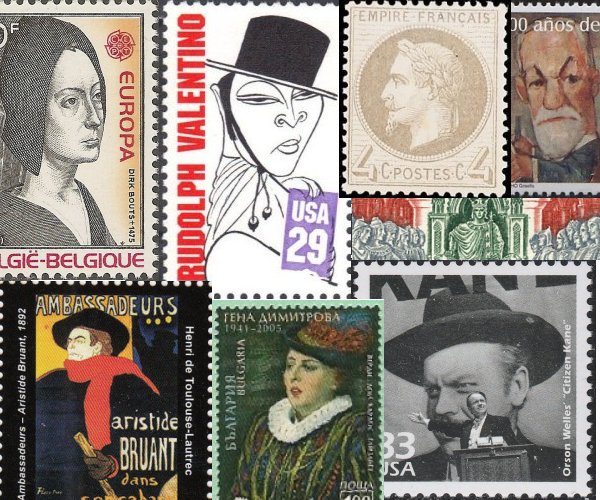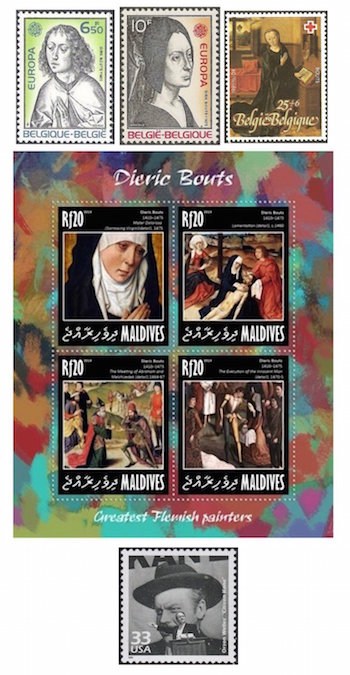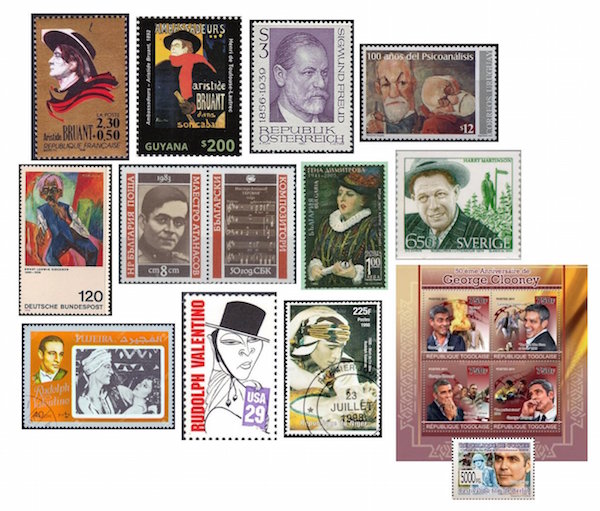The Arts on the Stamps of the World — May 6
An Arts Fuse regular feature: the arts on stamps of the world.

By Doug Briscoe
Another pretty full day here on Arts on the Stamps of the World, beginning with an early Netherlandish painter who died on this date in 1475. Dieric (or Dirk) Bouts the Elder was born about 1415. Not much is known of his early life; he may have studied with Rogier van der Weyden, whose influence, along with that of Jan van Eyck, can be seen in Bouts’s work. He was active in Leuven from 1457 and is credited with the first Flemish panel painting of the Last Supper (1464), which shows his use of a single vanishing point, making him one of the earliest northern painters to incorporate that effect (note the table, walls, ceiling, and floor). I know of no stamp that shows the entire work, but one from a Belgian pair shows the head of Saint John the Baptist, seated at Christ’s left. (There’s also an online image of the central panel in context.) Another detail, a woman’s head from Trial By Fire, is seen on the stamp’s partner. (If you’re interested in more about this particular painting, I warmly recommend you to a superb blog by a gentleman from Wales who identifies himself only as “Jonathan”; he offers a most informative description.) A third Belgian issue gives us a detail from Bouts’s Annunciation (1565-70). The minisheet from the Maldive Islands, meanwhile, offers up four more Bouts pieces: Mater Dolorosa (c1470-75), Lamentation (c1460), The Meeting of Abraham and Melchizadek (c1464-67), and The Execution of the Innocent Count (again I link to Jonathan’s analysis).
It’s the birthday of the great if unfulfilled Orson Welles (1915 – October 10, 1985) today. His supreme creation is celebrated on a US stamp of 1999.

Our next four subjects (two of them stamp designers!) are all Frenchmen. Alain-René Lesage (6 May 1668 – 17 November 1747) was a novelist, playwright, and translator whose best known work is probably the picaresque novel Gil Blas (1715-35). He began by translating plays from the Spanish (Lope de Vega, Calderón, et al.) and achieved no noteworthy success until 1707 (he was nearly forty) with his original play Crispin rival de son maître. In the same year he published his comic novel The Devil upon Two Sticks (Le Diable boiteux), the popularity of which led to several editions, and another play, Les Étrennes, which he later adapted as Turcaret, considered his finest work for the stage. Lesage wrote much more, both for the theater and in fiction. In his old age he was much celebrated as a raconteur and wit.
Albert Désiré Barre (6 May 1818 – 29 December 1878), was Chief Engraver of the Paris Mint from 1855 to his death, when he was succeeded by his brother. Their father had filled the office before them. Albert started as a painter and executed some frescoes in the chapel of Saint-Eustache. A major shift occurred when his father requested that Albert assist him at the mint beginning in 1845. Four years later France began issuing its first postage stamps, and father and son worked on these engravings together. I show one example from 1863, with the silhouette of Napoleon III. Next to it is one of the earliest Greek stamps (1861), a Hermes type, for which Barre also received the contract.
One of the most prolific stamp engravers from a later age was, coincidentally, named Albert. Albert Decaris (1901 – January 1, 1988), who had won the Concours de Rome at 19 for his painting, began working on French stamp designs in the 1930s, over the next half-century producing some 500 objects mostly for French and African postal services. As a stamp nut I wish I could show every damn one of them; as it is I’m probably overdoing it. At upper right is his 1960 contribution to the ever-changing series of “Marianne” definitives. The next row begins with what I believe was his very first effort in the field, marking the maiden voyage of the steamship Normandie in 1935. The bottom row consists of three of his designs for a colorful historical series issued in the late 60s and early 70s.
Before we depart from France, we salute cabaret singer Aristide Bruant (6 May 1851 – 10 February 1925), who is credited with the invention of the musical genre called chanson réaliste, a style that later came to be associated mostly with woman singers like Édith Piaf. In Montmartre he became friendly with Toulouse-Lautrec, one of whose posters shows Bruant in his trademark red scarf and black cape. That poster is reproduced on a stamp from Guyana.
We pause to pay honor to a man without whose work the art of the 20th and 21st (and presumably subsequent) centuries would be very different indeed, though he was not strictly speaking an artist himself: Sigmund Freud (6 May 1856 – 23 September 1939). In addition to his no-nonsense Austrian stamp I show a playful one from Uruguay marking the centenary of psychoanalysis.

An artist who suffered from mental illness was the German painter Ernst Ludwig Kirchner (6 May 1880 – 15 June 1938), whose experiences in World War I led to a breakdown from what I assume would be diagnosed today as PTSD. His parents were supportive of his desire to be an artist but encouraged him to seek greater security with a degree in architecture. With a few of his fellow students at the Royal Technical School of Dresden he founded the group Die Brücke (“The Bridge”), which sought to preserve the tradition of such painters as Dürer, Grünewald, and Cranach while absorbing newer influences. An example was in their revival of woodcuts as a medium. Following his early discharge from the army he began to suffer recurring breakdowns, addiction to Veronal and alcohol, and periods of institutionalization, but he was periodically allowed to return to his studio, which soon developed a reputation for free love and a culture of nudity. There was another breakdown in 1918 but his condition improved enough for him to hold exhibitions and make a name for himself. Old Farmer, seen on a 1974 stamp, comes from this period (1919-20). He was even made a member of the Prussian Academy of Arts in 1931. But the advent of fascism brought condemnations of his work—he was one of those impugned as “degenerate” by the Nazis in 1933. He was compelled to leave the Academy, and in 1937 several of his pieces were included in the infamous Munich show of “entartete Kunst“. More than 600 of his works were sold or destroyed. By this time living in Switzerland, Kirchner wrote: “Here we have been hearing terrible rumors about torture of the Jews, but it’s all surely untrue…There is a war in the air. In the museums, the hard-won cultural achievements of the last 20 years are being destroyed, and yet the reason why we founded the Brücke was to encourage truly German art…And now it is supposed to be un-German. Dear God. It does upset me”. After the Anschluss of Austria, Kirchner grew terrified at the prospect of the German invasion and/or annexation of Switzerland and took his own life by gunshot.
May 6 happens to be the birthday of two classical musicians from Bulgaria, composer and conductor Georgi Atanasov and soprano Ghena Dimitrova. Atanasov (1882 – November 17, 1931), having studied with Mascagni, wrote operas in the Italian style, infused with folk idioms. The label shows part of the score to Gergana (1917), the second of his six operas. He wrote an equal number of operettas. Atanasov also led military bands and wrote a great many marches for that ensemble. Thanks again to Marc-André Hamelin for giving me this stamp.
Ghena Dimitrova (1941 – 11 June 2005) studied at the Sofia Conservatory and, after winning a competition in 1970, at La Scala. She sang Turandot at Treviso in 1975, a role with which she was to become especially associated. She enjoyed five seasons at the Teatro Colón, Buenos Aires. Her US debut took place in 1981 (Elvira in Ernani) and her Met debut (again with Turandot) in 1988.
Another Nobel Prize laureate for literature is up next. There was some controversy over the election of Harry Martinson (6 May 1904 – 11 February 1978) and fellow Swede Eyvind Johnson in 1974 because both were members of the Swedish Academy and had campaigned for themselves. Effectively orphaned at a tender age (his father died, and his mother abandoned him), Martinson ran away from his foster home at sixteen and went to sea, traveling the world. On his return to Sweden he was at loose ends and was even arrested for vagrancy. By 1929, however, he was secure enough to marry and publish work in the first Swedish Modernist anthology. His 1935 novel Nässlorna blomma (Flowering Nettles) about “the hardships encountered by a young boy in the countryside” (write what you know!), was a popular success and went on to be translated into thirty languages. He remarried in 1942 and in 1956 wrote the science fiction poetry cycle Aniara, which was made into an opera by Karl-Birger Blomdahl in 1959. It was likely as a result of the accusations of exerting undue influence on the Nobel committee (that year’s other nominees included Graham Greene, Saul Bellow, and Vladimir Nabokov) that Martinson committed suicide at age 73.

Two movie idols, one from the silent era and one from today, are up next. Rudolph Valentino (May 6, 1895 – August 23, 1926) was born in Apulia as Rodolfo Alfonso Raffaello Pierre Filibert Guglielmi di Valentina d’Antonguella. After some time spent in Paris, he left for the United States in 1913, entering the country through Ellis Island. He took odd jobs in New York, was involved with a Chilean heiress who shot her ex-husband, and skedaddled out of town with a theatrical troupe for the west coast. Successful as a dancer, and with his striking looks, he was easily able to make the transition to film, though he was in quite a number of movies before The Sheik of 1921. Two years later he published a book of poetry, Day Dreams. Three years after that he was dead of a perforated ulcer. He was 31.
George Clooney (born 1961) is, if anything, even handsomer than Valentino. I expect you knew already that he is the nephew of Rosemary Clooney and, through her, a cousin of the Ferrers (the late Miguel, et al.), but did you know that one of his ancestors was a half-sister of Abraham Lincoln’s mother? Those seeking more details of Mr. Clooney’s curriculum vitae will no doubt be able to track them down somewhere.
I’m amazed to find no stamps for German-born film director Max Ophüls (born Maximillian Oppenheimer; 6 May 1902 – 26 March 1957), less surprised to find none for American historian T. H. White (May 6, 1915 – May 15, 1986).
A graduate of the University of Massachusetts with a B.A. in English, Doug Briscoe worked in Boston classical music radio, at WCRB, WGBH, and WBUR, for about 25 years, beginning in 1977. He has the curious distinction of having succeeded Robert J. Lurtsema twice, first as host of WGBH’s weekday morning classical music program in 1993, then as host of the weekend program when Robert J.’s health failed in 2000. Doug also wrote liner notes for several of the late Gunther Schuller’s GM Recordings releases as well as program notes for the Boston Classical Orchestra. For the past few years he’s been posting a Facebook “blog” of classical music on stamps of the world, which has now been expanded to encompass all the arts for The Arts Fuse.
